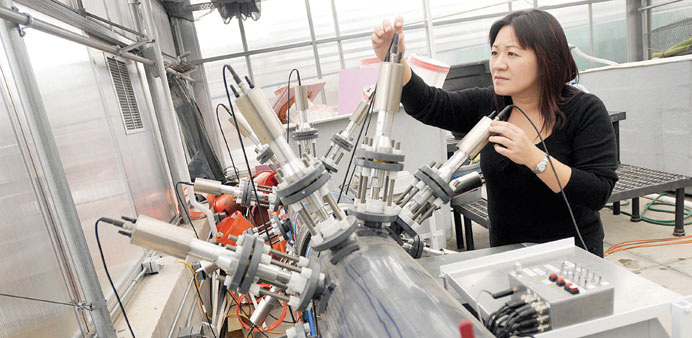* Montclair State Professor Meiyin Wu is reasearching ways of using ultrasound to kill off invasive species in ballast tanks of cargo ships. The ships pick up water in one port then dump it in another far away.
By James M O’Neill
The large cargo ships that steam daily into Newark Bay unload more than the colourful containers stacked on deck — from their holds they also can release millions of gallons of water teeming with tiny sea creatures from faraway ports-of-call.
These aquatic stowaways, which sometimes thrive in New Jersey’s local waters, can harm fisheries and clog the intake pipes of drinking water treatment facilities and power plants.
As a result, the US Coast Guard has ordered ships to treat ballast water and kill off any organisms. The most common treatment methods, however, involve chemicals, which then need to be discarded, or ultraviolet light, which can’t penetrate murky water.
A Montclair State University professor has been working on a contraption that could avoid those issues by treating the water with something quite simple — sound waves.
“Ultrasound has special properties that have already been in use as a disinfectant to control unwanted organisms, such as bacteria in laboratories or surgical settings,” said Professor Meiyin Wu, a biologist and director of the Passaic River Institute. “It has been used to disinfect swimming pools and drinking water.”
Locally, many invasive species have taken hold.
The Asian shore crab arrived in New Jersey in 1988 and has since spread to New England and North Carolina. “You can come across them in huge numbers,” said Judith Weis, a marine biologist at Rutgers University. “They reproduce very fast and have no strong site fidelity — they’ll wander around, which helps them spread further.”
Green crabs, which were introduced into Raritan Bay from Europe a century ago, have also spread to Maine, where they have damaged shell fisheries, Weis said. She has seen the Chinese mitten crab, a new invader within the past decade, in the Hudson River. It digs burrows in riverbanks, which can speed erosion.
Montclair State marine biologist Robert Prezant has studied the Asian clam, which was released into Canada about a century ago and has since spread across the United States — including into the Passaic River. Prezant said they can grow in concentrations of up to 20,000 per sq m. “They’re like a layer of concrete on the riverbed,” he said. “They compete with the native species of freshwater mussel for the same food sources.”
The zebra mussel, which has ravaged the Great Lakes since it arrived in ship ballast water from the Black Sea, has not yet reached New Jersey, Prezant said. “But it will get here,” he said. The state has a zebra mussel watch programme in place.
The Coast Guard rule about treating ballast water applies to new vessels built after December of this year and will apply to older vessels beginning with their first dry-docking after January 2016. Ballast water is taken on or released from a ship to help keep it balanced while being loaded, unloaded or travelling in the open ocean.
In 2004, the Coast Guard started requiring ships to exchange their ballast water while at sea, but the results have been mixed. Some organisms can still remain in sediment at the bottom of the ship’s tanks and the process can be dangerous — a number of ships have capsized, said Douglas Schneider, vice president for government affairs with the World Shipping Council. If there is bad weather, the exchange can’t be attempted at all.
Standard container ships can carry more than 5mn gallons of ballast water, Schneider said, with large crude oil carriers holding 10 times that amount. Up to 3,200 ships call each year on the six container terminals operated by the Port Authority of New York and New Jersey, with the bulk of them landing at Newark and Elizabeth.
The cost of installing a treatment system can be $1mn to $2mn per ship, not including the lost revenue from having the ship out of service for several months. Montclair State’s Wu came to the ballast water issue indirectly, while she was researching how to control the spread of the water chestnut plant on Lake Champlain.
The water chestnut is an invasive plant from Eurasia that floats on the water and can grow into dense impenetrable mats that block light from reaching native species growing beneath the water — species that fish and other organisms rely on.
But collecting the plant is slow and costly and trying to kill it with chemicals has other side effects.
So Wu contacted Junru Wu (no relation), a physicist at the University of Vermont, who had done ultrasound research for 25 years. “It can be very useful to kill the bacteria growing in milk and apple cider,” he said.
Junru Wu figured that ultrasound might work on the water chestnut because it relies on an air pocket to stay afloat. The sound waves could burst the air pocket, sending the plant to the lake bottom to decompose.
Their lab tests worked. But it was one thing to target the water chestnut in a controlled laboratory environment — it would be harder and less practical to treat it in a 500-square-mile lake.
To attract more funding, Wu needed to figure out a way to apply her work to other irritating species. The two researchers were able to secure a $673,000 federal grant because the US government was looking for ways to reduce the widespread impact of invasive species introduced through ship ballast water into the Great Lakes.
The device that they developed — which they call a BallastSolution — looks like a stylised, elongated metal porcupine. The machine can send sound waves at frequencies above the range of human hearing through the water as it flows through a pipe.
They built their device in Vermont, then took it apart, packed it into a van, drove it down to Montclair State, where Meiyin Wu had been hired, and reassembled it.
For the past year and a half, they have been testing its effectiveness at killing off the larval stages of many invasive species. They have also tested it on the larvae of mosquitoes.
They have been able to kill off 99% of organisms present in the water. It takes 10 to 20 seconds of exposure to the sound waves for the water to be disinfected, Meiyin Wu said.
She and Jenru Wu are talking to a number of potential investors to bring the device to the market.
“The ship owners’ primary interest is to buy a technology that works,” said the World Shipping Council’s Schneider. “They want the confidence in it given how costly it will be. If acoustic blasting works, it will certainly have a market.” — MCT



